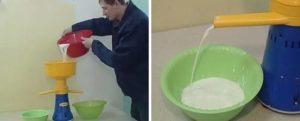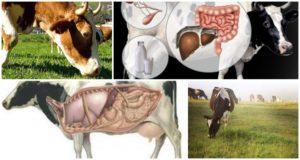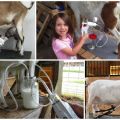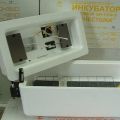Instructions for using the milking machine Farmer and how to assemble it
Even if the farm has one or two cows, the machine tools make milking much easier and make the process fast and of high quality. The Farmer milking machine for cows has a simple design and operates on the principle of vacuum milk intake. Thanks to the special trolley on wheels, it is easy to move the equipment around the barn.
How does the device work?
The manufacturer produces milking equipment for sheep, cows, goats. The main elements of the milking machine:
- an electric motor that starts the installation;
- dry type vacuum pump;
- wheelbase on which the pump and electric motor are located;
- aluminum teat cups with silicone linings;
- air hoses and milk line made of transparent plastic tubes;
- milking bucket-can with a capacity of 20 liters.
Overall dimensions of the assembled device: 845x450x650 mm, weight 25 kg. The assembly sequence of the device, the rules for its maintenance are spelled out in a special technical passport. Also, the manufacturer informs the consumer about possible malfunctions or problems in the operation of the device, ways of elimination.
Principle of operation
The device works on the basis of the "squeezing" effect. Feature of functioning - when air is pumped into a special glass, the inner cuff compresses the nipple, squeezing out the milk. As the air is pumped out, the nipple opens.
Through pipes connected to glasses, milk flows into cans. It takes 5-7 minutes to milk one cow. After the end of the process and turning off the unit, you must not immediately pull the glasses off the teats. You need to wait 1.5-2 minutes to exclude injuries to the nipples and udder.
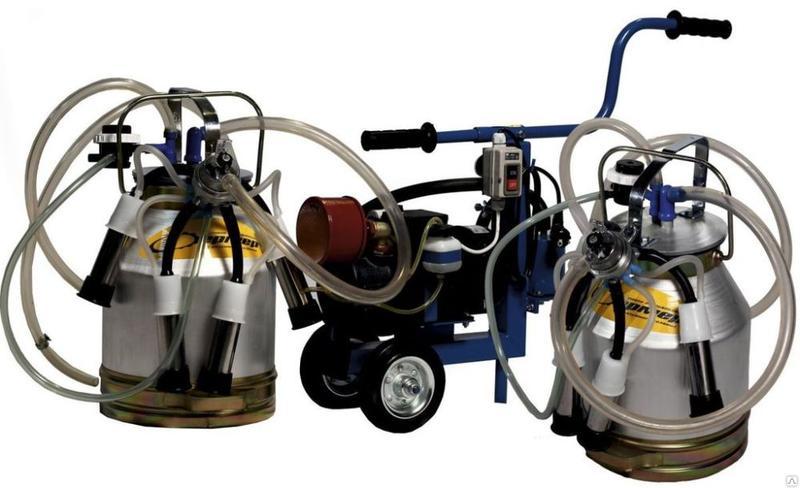
Pros and cons
The device is designed for milking one cow, or you can connect the equipment to two animals at the same time. With the condition of short breaks (3-4 minutes), 8-20 cows can be milked successively. Technique advantages:
- convenient installation and simple maintenance;
- low weight of the device;
- the equipment functions at high and low temperatures.
The device provides complete milking of cows. In this case, the milk immediately flows into the sealed chamber, and foreign particles do not contaminate it. Hot water is enough to clean the device properly.
The service life of the vacuum unit is increased thanks to this device.The main disadvantages of the milking machine are: unfavorable cyclic effect of teat liner, high cost of the device.

Milking equipment assembly
The technique is disassembled. It is not difficult to assemble the milking machine yourself - just follow the recommendations indicated in the instructions:
- The liner is placed in the cups so that the restraining rubber ring protrudes over the edge of the aluminum cup. Milk pipes are passed through glasses.
- The device is connected to the can through the holes located on the container lid.
- One silicone tube connects the can with a vacuum bottle.
- The can is also connected with a tube to a manifold (plastic spout) to which the teat cups are connected.
- Through a special pulsar mounted on the can, the third tube is connected to the collector (metal nose).
- The vacuum gauge, which allows you to monitor the working vacuum depth, is attached to the vacuum cylinder. The working indicator is 4-5 kPa.
The final stage of assembly - the can is installed on a wheelbase. Oil is poured into a special oil compartment.

Rules for the use of the milking machine "AD2"
Before putting glasses on the nipples, according to the instructions, it is necessary that a vacuum depth of a certain value be formed in the cavities. To extend the service life of equipment, you must follow certain rules for its use and maintenance:
- the washed apparatus is placed in storage disassembled;
- when assembling, it is important to ensure a strong connection of all elements;
- The teat cups must be securely placed over the teats of the udder.
Since cow's milk is fatty, it is sometimes recommended to use special products when flushing the equipment. Sodium hydrochloride is most often used (10 ml of the product is diluted in a ten-liter bucket of water). It is important to rinse the machine with clean water after using detergent.
To milk the cows without possible danger, it is worth periodically inspecting the elements of the installation: there should be no cracks on the rubber elements, milk or vacuum hoses, the electric drive should be intact.
It is also recommended to periodically check the function of the regulator and vacuum gauge.

Most common malfunctions
Any technique periodically breaks down or starts to work poorly. Some malfunctions of the milking machine can be corrected by yourself:
- low pressure in the hoses can be caused by the integrity of the tubing or rubber elements. The malfunction can be eliminated only by replacing damaged parts;
- there are often problems with the operation of the pulsator. As a rule, problems arise due to the ingress of dirt. To solve the problem, it is recommended to disassemble the device and thoroughly clean and rinse the pulsator components. Dry the parts before assembly;
- air suction problem occurs when rubber components are worn out. To eliminate the defect, the tubes are checked, the rubber elements are updated.
If the engine is not running, the cause may be a power outage or a problem with the vacuum pump. The issue with a vacuum pump is solved only by repair.
The Farmer milking machine is in demand both in small farms and in large livestock complexes. The device is not difficult to use, it takes an average of 6 minutes to milk one cow. Prevention consists in cleaning the device and checking the oil level in the system.
